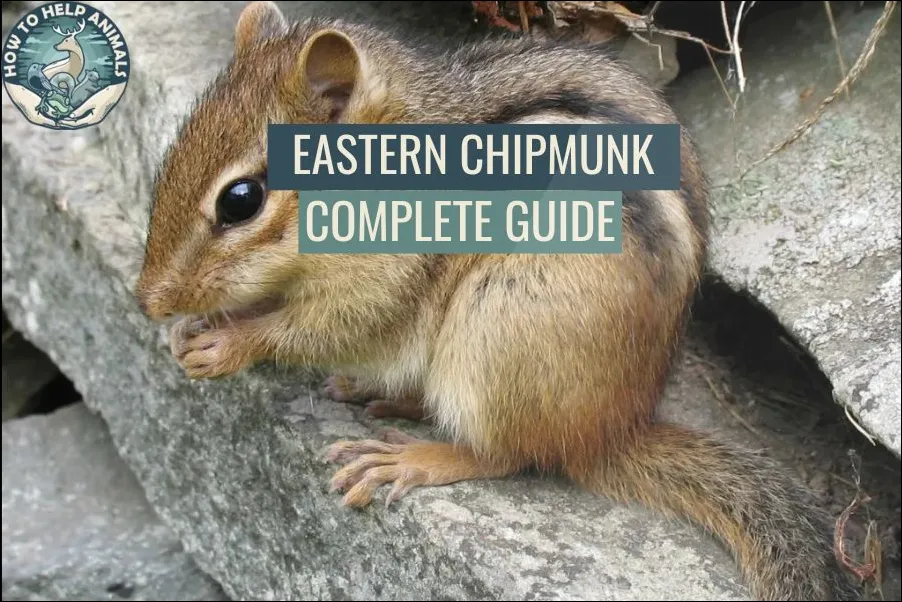
The morning sun filters through the oak canopy as a small, striped figure darts between fallen leaves, cheeks bulging with acorns. This energetic forager—the Eastern Chipmunk—represents one of North America’s most recognizable woodland residents, yet many people know surprisingly little about their complex behaviors and ecological importance.
The Eastern Chipmunk (Tamias striatus) is North America’s largest chipmunk species, distinguished by five dark stripes alternating with four light stripes running from head to rump. These ground-dwelling squirrels are expert food hoarders, capable of storing up to 8 pounds of nuts and seeds in their elaborate burrow systems for winter survival.
| Attribute | Details |
|---|---|
| Scientific Name | Tamias striatus |
| Size | 8-10 inches body, 3-4 inch tail |
| Weight | 70-142 grams (2.5-5.0 oz) |
| Lifespan | 2-3 years wild, up to 8 years maximum |
| Habitat | Deciduous forests, woodland edges, suburban areas |
| Diet | Omnivore: nuts, seeds, fruits, fungi, insects, bird eggs |
| Activity | Diurnal (most active mid-morning and mid-afternoon) |
| Conservation Status | Least Concern (stable populations) |
Physical Description
The Eastern Chipmunk stands out among North American squirrels with its distinctive striped pattern and compact build. Unlike the larger tree squirrels covered in our Complete North American Squirrel Species Guide, chipmunks are built for ground-dwelling life with shorter legs and a more robust body structure.
Their most recognizable feature consists of five prominent dark brown to black stripes separated by four lighter buff or white stripes running from the nose to the base of the tail. The central dark stripe extends along the spine, while two additional dark stripes run along each side. This pattern differs significantly from the solid coloration seen in species like the Eastern Gray Squirrel or Fox Squirrel.
The Eastern Chipmunk’s tail measures roughly one-third of their total body length and lacks the bushy plume characteristic of tree squirrels. Instead, their tail appears flattened with dark and light banding that continues the striped theme. The underside typically shows a rust-colored or orange-brown hue.
Their fur changes seasonally, with summer coats appearing brighter and more vibrant than winter pelage. Adult Eastern Chipmunks measure 8-10 inches in body length with tails adding another 3-4 inches. Weight varies seasonally from 70 grams in spring to 142 grams before winter hibernation as they build fat reserves.
Sexual dimorphism remains minimal, though males tend to be slightly larger than females. Both sexes possess large cheek pouches that can expand to three times the size of their head when filled with food—a crucial adaptation for their hoarding lifestyle.
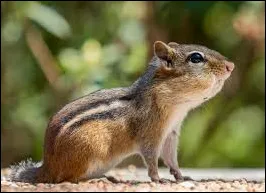
Habitat and Distribution
Eastern Chipmunks occupy a broad range across eastern North America, from southeastern Canada south to northern Georgia and west to the Great Plains. Their distribution overlaps with many tree squirrel species, but their habitat preferences differ significantly from arboreal species like the American Red Squirrel.
These adaptable rodents thrive in deciduous and mixed forests where oak, hickory, maple, and beech trees provide abundant mast crops. They show particular preference for forest edges, clearings, and areas with fallen logs or rock piles that offer both food sources and cover. Unlike the coniferous forest specialists such as the Douglas Squirrel, Eastern Chipmunks require diverse hardwood environments.
Suburban environments have proven increasingly suitable for Eastern Chipmunk populations. Parks, mature residential areas with established trees, and woodland preserves within urban boundaries often support healthy chipmunk communities. They readily adapt to human-modified landscapes provided sufficient cover and food sources remain available.
Elevation preferences range from sea level to approximately 4,000 feet, though they’re most abundant in lowland and mid-elevation forests. Their northern range limit appears constrained by growing season length and winter severity, while southern populations thin out where deciduous forests give way to predominantly pine forests.
Territory size varies with habitat quality and food availability. Individual chipmunks typically maintain home ranges of 0.25 to 1.5 acres, with core activity areas concentrated around their primary burrow systems. High-quality habitats with abundant mast-producing trees support higher population densities than marginal areas.

Diet and Feeding Behavior
The Eastern Chipmunk’s omnivorous diet reflects their opportunistic feeding strategy and seasonal food availability. Unlike specialized feeders, they consume over 30 different food types throughout the year, adjusting their preferences based on seasonal abundance and nutritional needs.
Tree nuts form the foundation of their diet, particularly acorns from various oak species, hickory nuts, beechnuts, and maple seeds. Their powerful jaws and specialized teeth allow them to crack shells that challenge smaller rodents. During peak mast years, a single chipmunk may cache thousands of nuts in their burrow system.
Seeds represent another crucial food category, including those from grasses, wildflowers, and shrubs. Sunflower seeds, both wild and from bird feeders, rank among their favorites. They show remarkable efficiency in seed selection, often discarding damaged or non-viable seeds while collecting only the highest quality specimens.
Fruits and berries provide important seasonal nutrition, particularly during summer months. Wild cherries, elderberries, strawberries, and blackberries supplement their diet with vitamins and natural sugars. In suburban areas, they readily consume ornamental fruits from landscaping plants.
Animal protein becomes increasingly important during breeding season and periods of rapid growth. Eastern Chipmunks hunt insects, including beetles, caterpillars, and moths. They occasionally take bird eggs and nestlings when opportunities arise, though this behavior represents a small percentage of their overall diet.
Fungi, including mushrooms and underground mycorrhizae, provide essential nutrients often lacking in plant foods. Their ability to locate and consume various fungal species gives them access to proteins and minerals unavailable to strict herbivores.
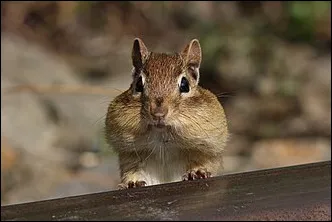
Water requirements are met primarily through their food, though they will drink from streams, puddles, or other water sources when available. Their efficient kidney function allows them to survive extended periods without direct water access.
Food caching behavior sets Eastern Chipmunks apart from many other small mammals. They create extensive larder hoards within their burrow systems, capable of storing 8 pounds or more of food for winter consumption. This behavior contrasts with the scatter-hoarding strategy employed by species like the Eastern Gray Squirrel.
Reproduction and Life Cycle
Eastern Chipmunk reproductive biology reflects their adaptation to temperate climates with distinct seasonal cycles. Their breeding patterns ensure offspring arrive during optimal conditions for survival and growth.
The breeding season typically begins in early March as males emerge from winter dormancy and compete for mating rights. Unlike year-round breeders, Eastern Chipmunks produce one or two litters annually, with timing dependent on food availability and local climate conditions.
Mating occurs through a complex courtship ritual involving chase sequences, vocalizations, and scent marking. Males establish temporary territories around potential mates, defending them against competitors through aggressive displays and physical confrontation. Successful males may mate with multiple females during the breeding season.
Gestation lasts approximately 31 days, with females giving birth to 2-8 young in underground nest chambers. Newborn chipmunks arrive hairless, blind, and completely dependent on maternal care. Birth timing coincides with spring food abundance, providing mothers with resources needed for milk production.
Nest chambers are carefully constructed within the burrow system, lined with soft materials including leaves, grass, and shredded bark. Females maintain these nursery areas at optimal temperatures through strategic placement and insulation. The underground location provides protection from predators and weather extremes.
Development proceeds rapidly during the first weeks of life. Eyes open at approximately 30 days, and young chipmunks begin exploring their burrow system shortly afterward. Weaning occurs at 6-8 weeks, though young may remain with their mother until late summer.
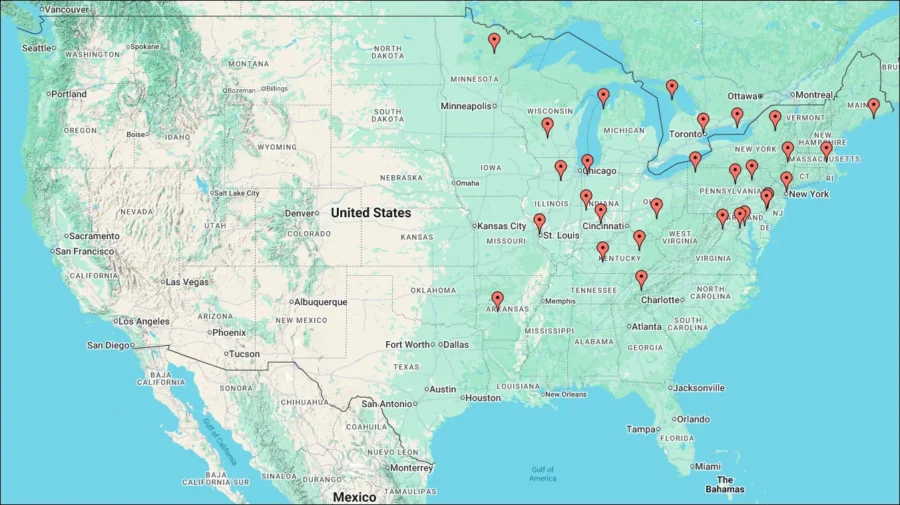
Sexual maturity arrives during their second year, though some females may breed during their first year if conditions are favorable. Adult size is reached by fall of their first year, though final weight may not stabilize until after their first winter.
Lifespan in the wild typically ranges from 2-3 years, though some individuals may survive up to 8 years under optimal conditions. Predation pressure, disease, and harsh winters limit survival rates, particularly during their first year of life.
Population cycles often correlate with mast production cycles, as abundant food years support higher reproductive success and juvenile survival. Poor mast years may result in reduced breeding activity or complete reproductive failure in some areas.
Behavior and Social Structure
Eastern Chipmunk social organization reflects their solitary lifestyle and territorial nature. Unlike the colonial behavior seen in some ground squirrels, each adult chipmunk maintains an individual territory centered around their burrow system.
Their extensive underground burrow networks represent remarkable engineering achievements. These systems may extend 20-30 feet in length with multiple entrances, storage chambers, nesting areas, and waste repositories. Construction requires weeks of excavation, with chipmunks moving tons of soil grain by grain in their cheek pouches.
Burrow entrances are strategically concealed near logs, rocks, or dense vegetation. Main tunnels typically run 2-3 feet underground, connecting various specialized chambers. Food storage areas may contain multiple bushels of cached nuts and seeds, while nesting chambers provide secure locations for raising young and winter dormancy.
Daily activity patterns follow a bimodal schedule with peak foraging periods during mid-morning and mid-afternoon. Unlike nocturnal species, Eastern Chipmunks remain active only during daylight hours, retreating to their burrows at dusk. This diurnal behavior helps them avoid many nocturnal predators while taking advantage of optimal foraging conditions.
Communication involves a complex system of vocalizations, body language, and scent marking. Their alarm calls include sharp “chip” notes that warn of aerial predators and longer “chuck” calls indicating ground-based threats. These vocalizations are often adopted by other forest species as general danger signals.

Territorial behavior intensifies during breeding season and periods of resource scarcity. While generally tolerant of neighbors, chipmunks will aggressively defend their core territory and food caches. Boundary disputes involve chasing, chattering, and occasionally physical confrontation.
Winter behavior differs dramatically from their active season routine. Eastern Chipmunks enter torpor—a state of reduced metabolic activity—rather than true hibernation. They periodically wake to feed on cached foods, with activity levels varying based on weather conditions and food availability.
Grooming represents an important daily activity, with chipmunks spending considerable time maintaining their fur condition. Their flexible spine allows them to reach all body areas, while their teeth serve as combs for removing debris and parasites.
Interaction with Humans
Eastern Chipmunks have adapted remarkably well to human-modified environments, often thriving in suburban and urban settings where suitable habitat remains available. Their relationship with humans represents a complex mix of appreciation, tolerance, and occasional conflict.
In residential areas, chipmunks frequently utilize landscaping features including stone walls, woodpiles, and garden structures for denning sites. They readily exploit bird feeders, gardens, and ornamental plants as food sources. Many homeowners enjoy watching their energetic foraging behavior and find their presence entertaining rather than problematic.
Garden damage occasionally occurs when chipmunks harvest bulbs, seeds, or fruits from cultivated plants. However, their impact rarely reaches the levels associated with larger mammals like groundhogs or deer. Their small size and selective feeding habits typically result in minor losses rather than wholesale destruction.
Bird feeder interactions represent the most common human-chipmunk encounter. These resourceful animals quickly learn to access seed supplies, often demonstrating remarkable problem-solving abilities in overcoming deterrent devices. Their cheek-stuffing behavior can rapidly empty feeders, leading some people to view them as nuisance animals.
Beneficial aspects of chipmunk presence include their role in pest control through insect consumption and their contribution to forest regeneration through seed dispersal. Many nuts cached but never retrieved grow into new trees, particularly in areas where larger seed dispersers have been eliminated.
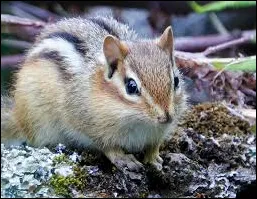
Pet interactions remain generally positive, though cats pose a significant threat to chipmunk populations in suburban areas. Dogs may chase chipmunks but rarely catch these agile animals. Homeowners can reduce conflicts by securing garbage, removing fallen bird seed, and maintaining tidy landscapes that minimize denning opportunities.
Educational value makes Eastern Chipmunks excellent subjects for nature observation and wildlife photography. Their diurnal habits and relative tolerance of human presence allow for close study of natural behaviors. Many schools and nature centers use chipmunk observation as an introduction to wildlife biology.
Disease transmission concerns remain minimal, as Eastern Chipmunks rarely carry diseases communicable to humans. Unlike some urban wildlife, they maintain relatively clean habits and avoid direct contact with people and pets.

Conservation Status
Eastern Chipmunk populations currently maintain stable status across most of their range, earning them a “Least Concern” designation from conservation organizations. However, localized population trends reveal concerning patterns that warrant monitoring and management attention.
Habitat loss represents the primary long-term threat to Eastern Chipmunk populations. Forest fragmentation, suburban development, and agricultural expansion continue to reduce available habitat across their range. Small, isolated populations face increased vulnerability to local extinctions due to genetic bottlenecks and environmental fluctuations.
Climate change implications include shifting temperature and precipitation patterns that may affect food availability and winter survival. Earlier spring warming could disrupt their synchronized emergence from winter torpor with peak food abundance periods. Extended summer droughts may reduce mast production and limit successful reproduction.
Predation pressure has intensified in many areas due to domestic cat populations and habitat modifications that favor certain predator species. Free-roaming cats kill millions of small mammals annually, with chipmunks representing frequent victims due to their ground-dwelling habits and predictable behavior patterns.
Regional population variations reflect local habitat quality and management practices. Areas with mature forest ecosystems and diverse tree species typically support healthy chipmunk populations, while regions dominated by young forests or monoculture plantations may experience population declines.
Research gaps exist regarding population trends in urban and suburban environments where chipmunks may be adapting to novel ecological conditions. Long-term studies are needed to understand how these populations differ from their forest counterparts and whether they represent sustainable communities.
Management recommendations focus on habitat preservation and connectivity. Maintaining forest corridors between fragmented habitats allows for genetic exchange and population stability. Urban planning that incorporates green spaces and mature trees can support chipmunk populations within developed areas.
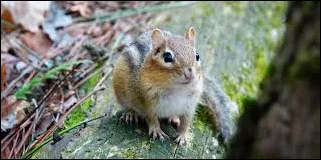
How to Help Eastern Chipmunks
Supporting Eastern Chipmunk populations requires understanding their habitat needs and implementing conservation-minded practices in both natural and human-modified environments. Individual actions can collectively make significant differences for local populations.
Habitat enhancement begins with native plant landscaping that provides natural food sources. Oak trees, hickories, maples, and other mast-producing species offer essential nuts and seeds. Shrubs like elderberry, serviceberry, and native cherries provide supplemental fruits and nesting cover. Even small properties can contribute by incorporating chipmunk-friendly plants.
Water source management helps chipmunks during dry periods. Shallow dishes, small ponds, or even dripping faucets provide necessary hydration. Position water sources near cover to allow safe access while maintaining escape routes from predators.
Burrow site protection involves preserving natural features that chipmunks use for denning. Rock piles, fallen logs, and unmaintained areas provide construction materials and concealment for burrow entrances. Avoid disturbing these features during spring and summer when active burrows may contain young.
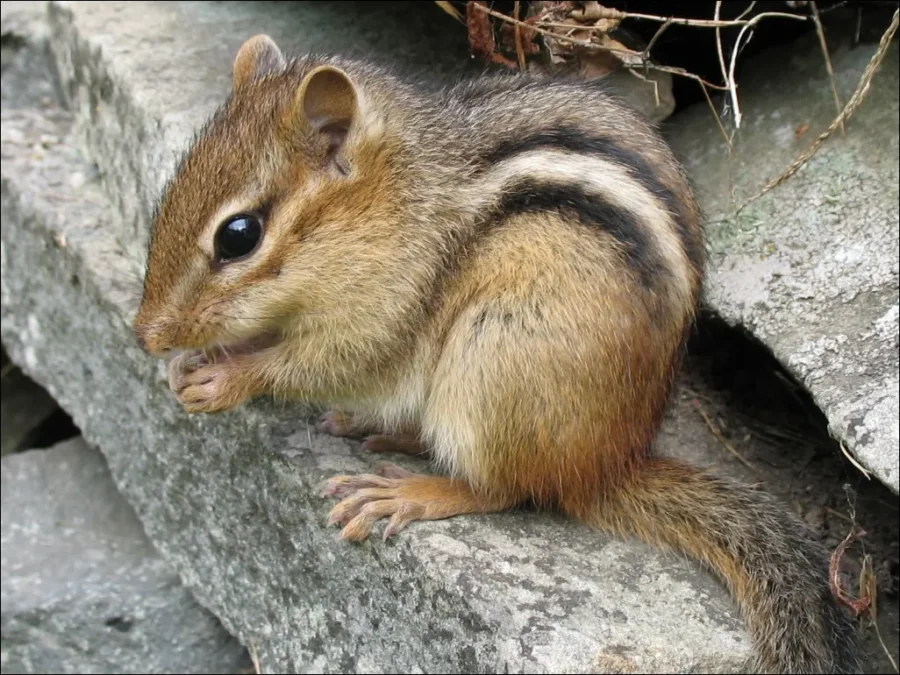
Responsible pet ownership significantly impacts chipmunk survival in residential areas. Keep cats indoors or in enclosed runs to prevent predation. Train dogs to avoid chasing wildlife and maintain leash control in areas with active chipmunk populations.
Chemical reduction protects chipmunks from pesticide exposure. Avoid using rodenticides, which can poison chipmunks directly or through contaminated prey. Choose organic gardening methods and biological pest controls that don’t threaten non-target species.
Bird feeder management can benefit both birds and chipmunks when approached thoughtfully. Use feeders designed to accommodate multiple species, clean regularly to prevent disease transmission, and position them to provide escape cover from predators. Consider offering chipmunk-specific foods like sunflower seeds in ground-level feeders.
Citizen science participation contributes valuable data for conservation efforts. Report chipmunk sightings to local wildlife agencies, participate in population surveys, and document behavioral observations. Photography and detailed notes help researchers understand population trends and habitat preferences.
Education and advocacy extend conservation benefits beyond individual properties. Share information about chipmunk ecology with neighbors, support habitat preservation initiatives, and advocate for wildlife-friendly development practices in your community.
Injured or orphaned chipmunk assistance requires contacting licensed wildlife rehabilitators rather than attempting home care. These professionals have the training and permits necessary for proper treatment and release. Keep domestic animals away from discovered animals and observe from a distance while arranging professional help.
Seasonal considerations include providing autumn food sources when chipmunks are caching for winter and avoiding major landscape disruptions during breeding and rearing seasons. Spring and early summer represent critical periods when human activities can most significantly impact chipmunk success.
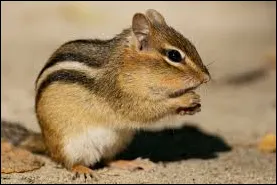
Conclusion
The Eastern Chipmunk represents one of North America’s most successful small mammal species, demonstrating remarkable adaptability to both natural forest ecosystems and human-modified environments. Their distinctive striped appearance, complex behavioral patterns, and ecological importance make them fascinating subjects for study and observation.
Understanding Eastern Chipmunk biology reveals intricate relationships between seasonal cycles, food availability, and survival strategies. Their elaborate burrow systems, sophisticated food caching behaviors, and precise timing of reproductive activities showcase evolutionary adaptations refined over thousands of years. These adaptations allow them to thrive in environments where many other small mammals struggle.
As we continue to modify natural landscapes, the Eastern Chipmunk’s success offers valuable lessons about wildlife adaptability and conservation. Their presence in suburban environments demonstrates that thoughtful human development can coexist with native wildlife populations when we consider species’ needs in our planning processes.
Future conservation efforts should focus on maintaining habitat connectivity, supporting native plant communities, and educating the public about the ecological value of these charismatic animals. Through understanding and appreciation, we can ensure that future generations will continue to enjoy watching these energetic striped acrobats as they dart through our forests and neighborhoods.
The Eastern Chipmunk’s story continues to unfold as they adapt to changing environments and face new challenges. By supporting their populations through informed conservation actions, we contribute to maintaining the biodiversity and ecological richness that makes North American forests such remarkable ecosystems. Their success serves as an indicator of overall ecosystem health and our effectiveness as environmental stewards.
Internal Links Added:
- Complete North American Squirrel Species Guide: https://howtohelpanimals.com/mammals/squirrels/complete-north-american-squirrel-species-guide/
- Eastern Gray Squirrel: https://howtohelpanimals.com/mammals/squirrels/eastern-gray-squirrel-complete-species-guide/
- Fox Squirrel: https://howtohelpanimals.com/mammals/squirrels/fox-squirrel-complete-species-guide/
- American Red Squirrel: https://howtohelpanimals.com/mammals/squirrels/american-red-squirrel-complete-species-guide/
- Douglas Squirrel: https://howtohelpanimals.com/mammals/squirrels/douglas-squirrel-complete-species-guide/
